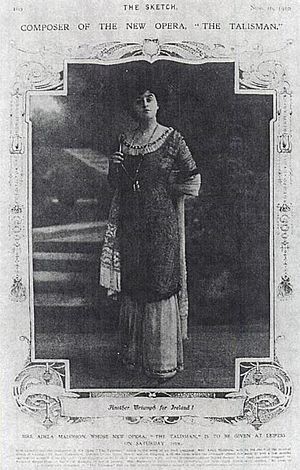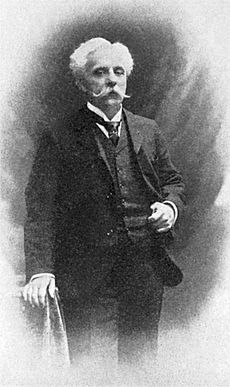Adela Maddison facts for kids
Katharine Mary Adela Maddison, also known as Adela Maddison, was a British composer. She was born on December 15, 1862, and passed away on June 12, 1929. Adela Maddison wrote many different types of music. These included operas, ballets, and songs. She also created music for instruments. Besides composing, she was a concert producer. This means she helped organize and put on musical shows.
Adela Maddison wrote many French songs. These were in a style called mélodie. For some years, she lived in Paris, France. There, she was a student and friend of the famous composer Gabriel Fauré. Later, she lived in Berlin, Germany. In Berlin, she wrote a German opera. This opera was performed in Leipzig. When she returned to England, she created music for the Rutland Boughton's Glastonbury Festivals.
Contents
Biography
Early Life and Music
Adela Maddison was born in London, England. Her birth date was December 15, 1862. Her father was Vice Admiral Louis Symonds Tindal. Her mother was Henrietta Maria O'Donel Whyte. Adela grew up in London.
On April 14, 1883, she married Frederick Brunning Maddison. He was a barrister (a type of lawyer) and a former footballer. They had two children, Diana and Noel. They were born in 1886 and 1888. Adela's first published music came out in 1882. Her collection of Twelve Songs in 1895 showed her unique musical style.
Time in Paris
Around 1894, Adela and her husband helped Gabriel Fauré become known in London. Her husband worked for a music publishing company. This company published Fauré's music from 1896 to 1901. Adela translated some of Fauré's songs into English. She also translated his choral work La naissance de Vénus. Fauré used her translation in 1898. He conducted a large choir at the Leeds Festival.
Fauré was a good friend of the Maddison family. In 1896, he spent his vacation at their home in Saint-Lunaire, Brittany. Adela became Fauré's student. He believed she was a very talented composer. She wrote many songs using poems by famous writers. Fauré even said her music for the poem Hiver was amazing.
From 1898 to about 1905, Adela lived in Paris. Fauré dedicated his Nocturne No. 7, Op. 74, to her in 1898. This piece showed his feelings for her. Fauré gave her the original music for this piece. It is now kept in the Bibliothèque nationale de France. In Paris, she also met other famous composers. These included Delius, Debussy, and Ravel. She organized concerts where her own music and others' music were performed. She even hosted the first performance of Delius's opera Koanga at her home in March 1899. Fauré was one of the musicians who performed there.
Moving to Berlin and Glastonbury
After Paris, Adela moved to Berlin, Germany. She continued to organize concerts there. She also composed an opera called Der Talisman. This opera was performed in Leipzig in 1910. In Germany, she became lifelong friends with Martha Mundt. Martha was an editor for a socialist newspaper in Berlin. Martha Mundt was born in 1872 in Königsberg. She studied sociology and economics.
Adela and Martha left Germany for France. Martha then worked for the Princesse de Polignac. When World War I began, they moved to London. Their friends in England included Radclyffe Hall and Mabel Batten. Martha Mundt returned to Berlin during the war.
Adela Maddison moved to Glastonbury, England. She spent several years creating music for the Glastonbury Festivals. One of her works was the ballet The Children of Lir. This ballet was later performed at the Old Vic theatre in 1920.
Later Years and Legacy
Adela's piano quintet, written in 1916, was first performed in 1920. It was a great success. She continued to write operas and songs. She also kept organizing concerts into the 1920s.
From the early 1920s, Martha Mundt lived in Geneva, Switzerland. She worked for the International Labour Organization (ILO). She was an information officer. Martha became the ILO's officer for women's and children's employment issues. She also worked with feminist organizations. Martha represented the ILO at many international meetings. Adela often traveled to Geneva to visit Martha.
Adela Maddison passed away in Ealing, London, in 1929. Sadly, many of the musical scores she created have been lost. This includes the music she wrote in Paris, Berlin, and for the Glastonbury Festivals.
What Music Did She Write?
Here are some of Adela Maddison's known works:
Operas
- Der Talisman (1910)
- Ippolita in the Hills (1926)
Ballets
- The Children of Lir (1920)
Chamber Music
- Piano quintet (1916)
Songs
- Deux Mélodies (1893), with words by Sully Prudhomme and Coppée
- Twelve Songs (1895), with words by Rossetti, Shelley, Swinburne, Tennyson, and others
- Little Fishes silver (1915), translated by Maddison
- Mary at Play (1915), translated by Maddison
- The Ballade of Fair Agneta (1915), translated by Maddison
- Lament of the caged Lark (1924)
- Tears (1924), translated from Wang Sen-Ju
- The Heart of the Wood (1924), translated from an old Irish poem
- The Poet complains (1924), translated from an old Irish poem



